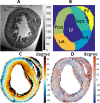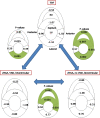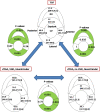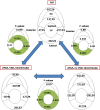Ex vivo cardiovascular magnetic resonance diffusion weighted imaging in congenital heart disease, an insight into the microstructures of tetralogy of Fallot, biventricular and univentricular systemic right ventricle
- PMID: 32951605
- PMCID: PMC7504600
- DOI: 10.1186/s12968-020-00662-8
Ex vivo cardiovascular magnetic resonance diffusion weighted imaging in congenital heart disease, an insight into the microstructures of tetralogy of Fallot, biventricular and univentricular systemic right ventricle
Abstract
Purpose: Common types of congenital heart disease exhibit a variety of structural and functional variations which may be accompanied by changes in the myocardial microstructure. We aimed to compare myocardial architecture from magnetic resonance diffusion tensor imaging (DTI) in preserved pathology specimens.
Materials and methods: Pathology specimens (n = 24) formalin-fixed for 40.8 ± 7.9 years comprised tetralogy of Fallot (TOF, n = 10), dextro-transposition of great arteries (D-TGA, n = 8) five with ventricular septal defect (VSD), systemic right ventricle (n = 4), situs inversus totalis (SIT, n = 1) and levo-TGA (L-TGA, n = 1). Specimens were imaged using a custom spin-echo sequence and segmented automatically according to tissue volume fraction. In each specimen T1, T2, fractional anisotropy, mean diffusivity, helix angle (HA) and sheet angle (E2A) were quantified. Pathologies were compared according to their HA gradient, HA asymmetry and E2A mean value in each myocardial segment (anterior, posterior, septal and lateral walls).
Results: TOF and D-TGA with VSD had decreased helix angle gradient by - 0.34°/% and remained symmetric in the septum in comparison to D-TGA without VSD. Helix angle range was decreased by 45°. It was associated with a decreased HA gradient in the right ventricular (RV) wall, i.e. predominant circumferential myocytes. The sheet angle in the septum of TOF was opposing those of the left ventricular (LV) free wall. Univentricular systemic RV had the lowest HA gradient (- 0.43°/%) and the highest HA asymmetry (75%). HA in SIT was linear, asymmetric, and reversed with a sign change at about 70% of the depth at mid-ventricle. In L-TGA with VSD, HA was asymmetric (90%) and its gradients were decreased in the septum, anterior and lateral wall.
Conclusion: The organization of the myocytes as determined by DTI differs between TOF, D-TGA, L-TGA, systemic RV and SIT specimens. These differences in cardiac structure may further enlighten our understanding of cardiac function in these diverse congenital heart diseases.
Keywords: Congenital heart disease; Dextro; Diffusion tensor imaging; Ex vivo; Levo; Microstructure; Situs inversus; Systemic right ventricle; Tetralogy of Fallot; Transposition of the great arteries; Ventricular septal defect.
Conflict of interest statement
C.T., A.Y, T.G. and B.P declare that they have no competing interests.
Figures






Similar articles
-
Automated biventricular quantification in patients with repaired tetralogy of Fallot using a three-dimensional deep learning segmentation model.J Cardiovasc Magn Reson. 2024 Winter;26(2):101092. doi: 10.1016/j.jocmr.2024.101092. Epub 2024 Sep 11. J Cardiovasc Magn Reson. 2024. PMID: 39270800 Free PMC article.
-
Frontal QRS-T angle and ventricular mechanics in congenital heart disease.Heart Vessels. 2020 Sep;35(9):1299-1306. doi: 10.1007/s00380-020-01601-4. Epub 2020 Apr 3. Heart Vessels. 2020. PMID: 32246195
-
Factors associated with right ventricular dilatation and dysfunction in patients with chronic pulmonary regurgitation after repair of tetralogy of Fallot: analysis of magnetic resonance imaging data from 218 patients.J Thorac Cardiovasc Surg. 2014 Dec;148(6):2589-95. doi: 10.1016/j.jtcvs.2014.07.051. Epub 2014 Aug 1. J Thorac Cardiovasc Surg. 2014. PMID: 25173118
-
Right ventricle in congenital heart disease: is it just a "weaker" left ventricle?Arch Mal Coeur Vaiss. 2006 Dec;99(12):1244-51. Arch Mal Coeur Vaiss. 2006. PMID: 18942528 Review.
-
The Role of Speckle-Tracking Echocardiography in Predicting Mortality and Morbidity in Patients With Congenital Heart Disease: A Systematic Review and Meta-analysis.J Am Soc Echocardiogr. 2024 Feb;37(2):216-225. doi: 10.1016/j.echo.2023.11.003. Epub 2023 Nov 14. J Am Soc Echocardiogr. 2024. PMID: 37972793
Cited by
-
Impact of intraventricular septal fiber orientation on cardiac electromechanical function.Am J Physiol Heart Circ Physiol. 2022 Jun 1;322(6):H936-H952. doi: 10.1152/ajpheart.00050.2022. Epub 2022 Mar 18. Am J Physiol Heart Circ Physiol. 2022. PMID: 35302879 Free PMC article.
-
A groupwise registration and tractography framework for cardiac myofiber architecture description by diffusion MRI: An application to the ventricular junctions.PLoS One. 2022 Jul 18;17(7):e0271279. doi: 10.1371/journal.pone.0271279. eCollection 2022. PLoS One. 2022. PMID: 35849598 Free PMC article.
-
Effects of cardiac growth on electrical dyssynchrony in the single ventricle patient.Comput Methods Biomech Biomed Engin. 2024 Jun;27(8):1011-1027. doi: 10.1080/10255842.2023.2222203. Epub 2023 Jun 14. Comput Methods Biomech Biomed Engin. 2024. PMID: 37314141 Free PMC article.
-
The right ventricle in tetralogy of Fallot: adaptation to sequential loading.Front Pediatr. 2023 Mar 16;11:1098248. doi: 10.3389/fped.2023.1098248. eCollection 2023. Front Pediatr. 2023. PMID: 37009270 Free PMC article. Review.
-
Right Ventricular Remodeling and Function in Hypoplastic Left Heart Syndrome.JACC Adv. 2024 Nov 20;3(12):101411. doi: 10.1016/j.jacadv.2024.101411. eCollection 2024 Dec. JACC Adv. 2024. PMID: 39635539 Free PMC article. Review.
References
-
- Popelová JR, Gebauer R, Černý Š, et al. Operations of adults with congenital heart disease – single center experience with 10 years results. Cor Vasa. 2016;58:e317–e327. doi: 10.1016/J.CRVASA.2015.12.005. - DOI
Publication types
MeSH terms
LinkOut - more resources
Full Text Sources

